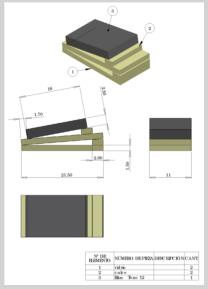
NavList:
A Community Devoted to the Preservation and Practice of Celestial Navigation and Other Methods of Traditional Wayfinding
Re: Butterfly Bris Prototype
From: Andrés Ruiz
Date: 2009 Jun 19, 11:18 +0200
From: Andrés Ruiz
Date: 2009 Jun 19, 11:18 +0200
If you are interested in a CAD 3D model of a Bris Sextant, I can send you a SolidWorks file. The viewer is free: http://www.edrawingsviewer.com/. The drawing is attached. If you don’t want to cut the glass, the bris sextant is bigger but also work. And for another angles between the glass. The welding glass filter must be tone 12 in order to protect your eyes, (European norm EN169). I built my own for just 1.35 € Anyway, Sven Yrvind, the developer of the Bris sextant starts selling it again: http://www.yrvind.com/present_project.html Andrés Ruiz Navigational Algorithms http://www.geocities.com/andresruizgonzalez -----Mensaje original----- De: NavList@fer3.com [mailto:NavList@fer3.com] En nombre de frankreed@HistoricalAtlas.com Enviado el: viernes, 19 de junio de 2009 6:07 Para: NavList@fer3.com Asunto: [NavList 8711] Re: Butterfly Bris Prototype Hewitt, you wrote: "I've been wanting to try one of these for some time. Are there any detailed instructions around?" They're really simple to make, but I think you should take Greg up on his offer to send you one. :-) A Bris sextant is a special case of a fixed angle sextant. Those can be instructive to make, too. Take a pair of small mirrors and affix them to a small board or otherwise arrange for them to be perpendicular to some common plane. They'll be angled relative to each other and offset slightly (just picture the mirrors of a normal sextant ignoring the rest of the instrument). Scrape half of the backing off of one mirror to turn it into a horizon glass. Then calibrate it by an observation of a known angle. Note that a fixed angle sextant and a Bris sextant require much the same adjustments as any reflecting instrument. When you take altitudes with a Bris sextant, you have to "swing the arc" and you also have to ensure collimation of the line of sight. Note that the important advantage of a Bris sextant compared with a basic fixed angle sextant is that it has multiple reflections so you get three or four fixed angles in one small package. The disadvantage is that it only works with the Sun. So picture this: Get a board or a metal plate 4"x24". Get twenty little mirrors about 1" square. Arrange them in pairs up the length of the board (attach a handle on the other side of the board). Each pair of mirrors constitutes a fixed angle sextant which you can "fix" to your favorite observation angles, maybe multiples of six degrees from 10 to 70 degrees (you'll fix them approximately upon construction, but the real values of the angles are found by trial). When you're done, you've got more angles than a Bris and the ability to use stars, planets, and the Moon, too. --I'm not seriously recommending such a thing, but it's an interesting exercise in seeing what really matters in a sextant when it comes to measuring angles. -FER --~--~---------~--~----~------------~-------~--~----~ Navigation List archive: www.fer3.com/arc To post, email NavList@fer3.com To , email NavList-@fer3.com -~----------~----~----~----~------~----~------~--~---







